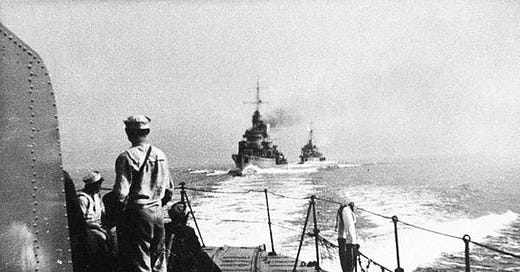Many myths and stories exist about the Polish armed forces in the defence of the homeland from the dual invasion of 1939 by the Soviets and the Nazis but very little is written about the Navy. So what was the Polish Navy’s input?
The German Lake
The German Navy of 1939 was inferior in numbers and size of ships compared to the UK, France and Italy and would struggle to hold superiority in any waterway except the Baltic.
The geography of the Baltic Sea went a long way towards reinforcing the German’s advantage. The only way into the Baltic was through the narrow and relatively shallow Danish Strait which could be easily mined and patrolled by the Luftwaffe.
The Germans had other reasons to want to prioritise securing the Baltic with the main one being to secure vital Swedish Iron ore which was needed for the war industry. It would also provide a safe place to train the Navy’s sailors and repair and refit warships beyond the range of the British and French bombers. Finally for war against Poland it was a perfect route to bring in supplies, reingforcements and provide coastal artillery support.
For the proposed Fell Weiβ (invasion of Poland) Admiral Conrad Albrecht was put in charge of the Kriegsmarine’s operations and Vizadmiral Heman Densch commanded the surface vessels in the theatre with his flag on the light cruiser Nürnberg. Albrecht had to direct his vessels to blockade the bay of Danzig, neutralise the Polish Navy and support the Army’s assault on Gdynia, Westerplatte and Hel Peninsula.
Although numerically inferior to the German navy the Polish had several great advantages. Admiral Jozef Unrug’s main surface fleet consisted of the four destroyers of the Dywizjon Kontrtopedowcow – the Grom, Burzaq, Blyskawica and Wicher. This force was backed up by the patrol submarines Orzel and Wilk. Unrug knew the Germans would quickly gain aerial and naval superiority even if only by sheer numbers and his two submarines were operating with the disadvantage of relatively shallow water making them easier targets, but he still had two trump cards.
The first was that the shallow waters and the nature of the bay made it perfect for laying mines which would cause the Germans to hesitate in sending vessels into to danger and require them to have to sweep the area to clear a path which would take time. For the purpose of mine laying Unrug had the submarines Sep, Zbik and Rys as well as a force of surface boats led by the minelaying destroyer Gryff.
The Second was a network of powerful artillery batteries ranging in size between 75 mm ( 3”) and 125mm (5”) dug into the sand dunes and woodlands making them difficult to hit from the air and the sea, giving them range to protect Hel, Gdynia and the surrounding hinterland but crucially, exclude the Germans from the bay of Puck. The main batteries were Grecka, Dunska and Cyplowa and were powerful enough to sink a destroyer and savage a cruiser.
The Kriegsmarine hoped to overwhelm the Polish quickly with sheer numbers and on 31st August Densch moved his surface vessels into the Baltic in readiness. The Polish hadn’t be idle though and had come up with several plans of action which were already under way to meet the aggressor.
Keep reading with a 7-day free trial
Subscribe to Chris’s Naval History Substack to keep reading this post and get 7 days of free access to the full post archives.




